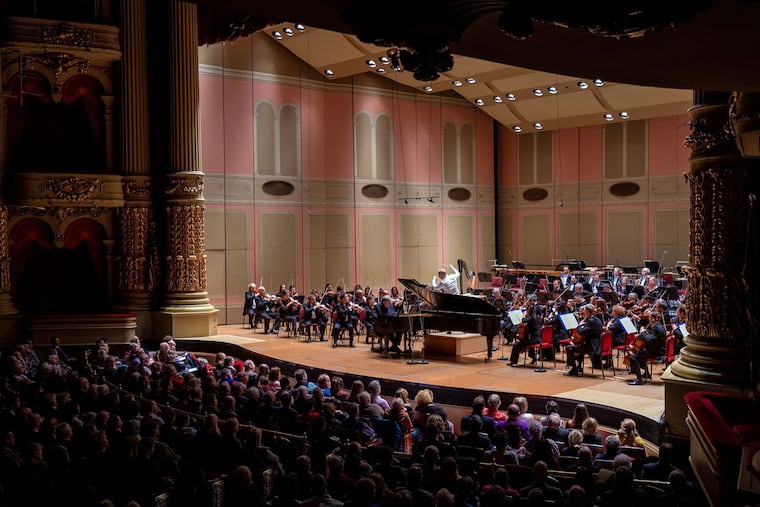After nearly two decades, Philadelphia Orchestra returns to Academy of Music for subscription concert
The performance of Rachmaninoff's "Symphony No. 3" led by Yannick Nézet-Séguin brought new emotional weight to a piece so memorably recorded at the Academy in 1939 under the composer’s direction.

Every year on Academy Ball night, the Philadelphia Orchestra does, indeed, go home again — a block up Broad Street from the Kimmel Center to the Academy of Music, where the orchestra first achieved its international reputation.
On Thursday night the ensemble had another homecoming, its first subscription concert at the Academy since decamping to the Kimmel Center in 2001. And it did so with a sense of occasion.
The concert began with a closed curtain and orchestra president and CEO Matias Tarnopolsky giving a quick, charming tour of the ornate architectural details of the 1857 hall, from the gilded sculptures holding up the ceiling to the chandelier containing 23,000 crystals. And when the curtain was ultimately raised, there was the Philadelphia Orchestra and Yannick Nézet-Séguin facing the audience, poised, smiling, and ready for performance.
Then there was the time-travel element. The Rachmaninoff Symphony No. 3 was written for the orchestra, premiered in 1936, and then recorded at the Academy in 1939 under the composer’s direction. The often reissued recording is one of the few that this pianist/composer made as a conductor, but it inspires more curiosity than veneration. I’d take the Thursday performance led by Nézet-Séguin any day. And it’s interesting to consider why.
The composer’s recording gives you the “what” aspect of the symphony — clearly outlining the proportions, tempos, and ebb and flow of the music. But Nézet-Séguin habitually asks “What does it mean?” And in this piece, his view of the symphony was more volatile and on-edge than the composer’s.
In his own performance, Rachmaninoff maybe wanted the similar endings of the first and second moments — in which the music trails off into unknown regions — to stay enigmatic. Nézet-Séguin found shifting multiple meanings and emotional weight.
The Ravel-like second movement with its playful array of orchestral colors was the sort of thing that brings out the best in Nézet-Séguin, and that might’ve happened on Thursday. But that was when the Academy acoustics became a buzzkill.
As resplendent as it looks, the Academy sounds dull. From my first-tier seat, the sound lacked any bloom, sparkle, or glow — due to an acoustical decline that is said to have happened amid renovations during the later years of the Eugene Ormandy era (1936-1980). I’m told that the sound onstage is quite good. But only the incidental solos from instruments positioned close to the front of the stage had much presence.
So, does the authenticity element — the original orchestra and venue — count for anything? In this case, it’s more a point of departure than a road map, for me.
But that’s a personal, somewhat academic question, and one that will be discussed in an upcoming panel featuring Nézet-Séguin, the subject being a recently discovered recording of Rachmaninoff playing his own Symphonic Dances. (It’s presented by Penn Libraries and sold out, but can be live streamed at 6:15 p.m. Jan. 31 at facebook.com/PennLibraries.)
Back to the concert: The durable Yefim Bronfman has much mileage under his fingers, and it showed in Thursday’s performance of Beethoven’s Piano Concerto No. 4. His famous filigree sense of line was not quite as crystalline as usual, and his rhythmic buoyancy not quite as palpable.
He often projected great sensitivity. And the second-movement confrontation between piano and orchestra was eloquently stark with the aid of Nézet-Séguin. But much of the performance would’ve benefited from a greater sense of discovery. So many of his phrase readings suggested he’s been there too many times before.
The new piece on the program, Vivian Fung’s Dust Devils, could’ve been written for the occasion, considering how much its coloristic playfulness resembled passages in the Rachmaninoff symphony’s middle movement.
In fact, Dust Devils dates back to 2011, and lives up to its title with a lot of swirling musical activity and ominous underlying tension suggesting influences from the late Christopher Rouse. Canadian composer Fung is clearly a master of the orchestral medium, even if this particular piece, like real-life dust devils, is there and gone, leaving only fleeting ethereal memories.
The program is repeated at 2 p.m. Friday. Jan. 24. and Sunday, Jan. 26. Tickets: $39 to $174. Information: 215-893-1999 or philorch.org.